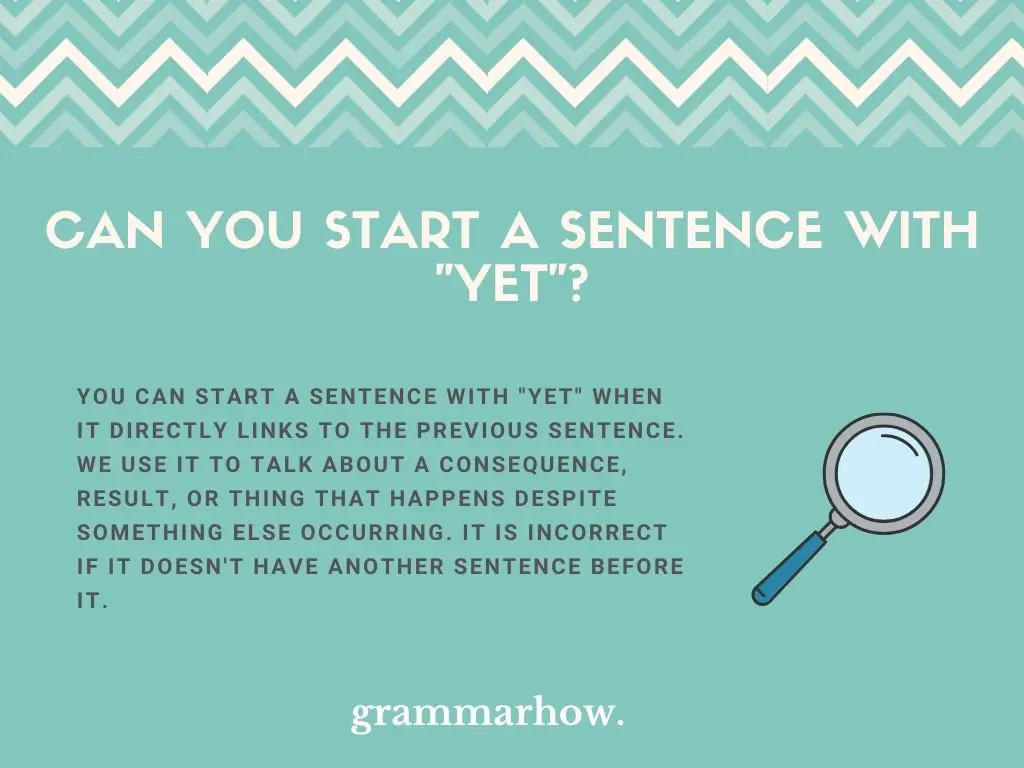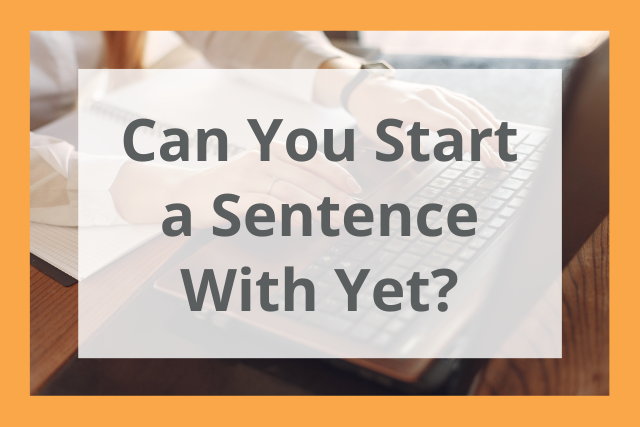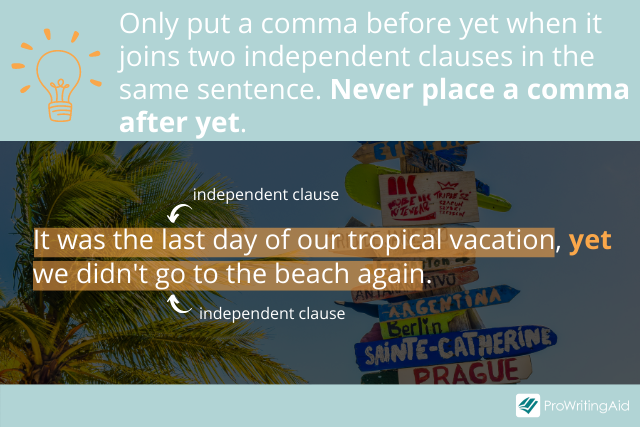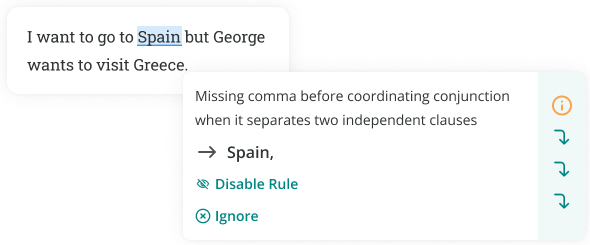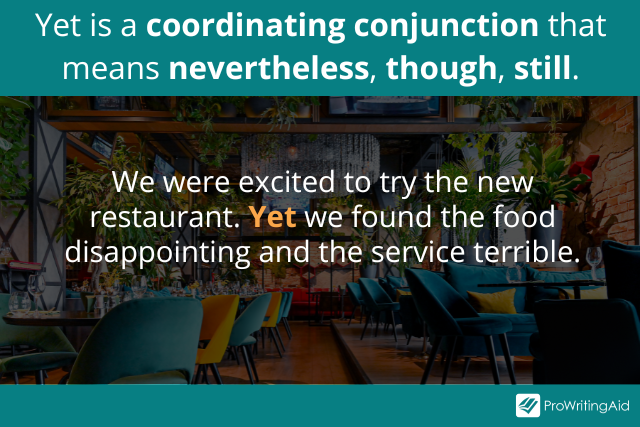Sometimes, we’re taught that starting a sentence with certain words is incorrect. This is a common English myth, and this article will debunk it. This time, we’ll look at starting a sentence with yet, and how we can make sure we’re using it correctly every time.
You can start a sentence with “yet” when it directly links to the previous sentence. We use it to talk about a consequence, result, or thing that happens despite something else occurring. It is incorrect if it doesn’t have another sentence before it.
Typically, we use “yet” to combine two sentences with each other. However, in certain forms of writing, it may be more beneficial to keep the sentences separate, while the need for using “yet” is still apparent in the piece of writing.
In these cases, it’s likely that we want to keep our sentences short and easy to comprehend. For this reason, we’ll place a period between the first sentence and the sentence that starts with “yet.”
Once we place this period, it’s simple to complete the second sentence. Any sentence that starts with “yet” usually means “despite that” or “but,” which works well when we want to show a further point to whatever we just mentioned.
What Does “Yet” Mean At The Beginning Of A Sentence?
Now let’s look closer at how “yet” works and what it means when it’s at the beginning of a sentence.
“Yet” means “in spite of” or “but” when we write it at the start of a sentence. We use it to show that while the first sentence might have had an obvious effect on something, the second sentence (starting with “yet”) was unaffected by that thing.
The definition of “yet,” according to The Cambridge Dictionary, is “despite that; used to add something that seems surprising because of what you have just said.”
It’s a great way to show how two things might interact with each other. It can refer to the action that someone takes or the result of some form of experiment.
“Yet” is a fairly common word in English, and we use it in many ways to mean “despite.” At the same time, it can also mean that something hasn’t happened at this time, though it is bound to happen at some point in the future.
Examples Of How To Use “Yet” At The Beginning Of A Sentence
We’ll take a look at some examples of starting a sentence with “Yet.” From these examples, you’ll have a much better understanding of how you can do it yourself without making any obvious grammatical errors.
- She didn’t think she was going to catch her bus today. Yet, somehow she still managed to make it before it arrived.
- He wasn’t going to take this one lying down, and he was going to do something about it. Yet, when confrontation came, he failed to show!
- It wasn’t easy for me to steal all of these diamonds from the bank. Yet, I made short work of the security guards once I was on my way out.
- You should have been there because I was on top form. Yet all you seem to want to do is stay at home and waste your life away!
- I couldn’t believe what I was seeing unfold before my very eyes! Yet, there it was, as clear as day!
- He wasn’t supposed to be out tonight, and I didn’t expect to see him. Yet, I guess he changed his mind and wanted to hit the clubs.
- There have never been any sightings of an extraterrestrial spacecraft. Yet, I remain hopeful that one day we will spot them.
We can use “yet” at the start of a sentence to mean “however” or “up until now.” It works well when we want to show that it relates directly to the previous sentence, and the effect of the previous sentence has little to no overall effect on the current outcome.
Where Should I Place The Comma When Using “Yet” At The Beginning Of A Sentence?
Punctuation rules can be tricky to master. Learning how to punctuate “yet” at the beginning of a sentence comes with difficulties of its own since there are two different ways to use it. The comma rules can be particularly challenging.
You should place a comma after “yet” when using it to mean “however” or “despite that.” You do not need to place a comma when you want “yet” to mean “up until now.”
To help you understand the differences between comma usage, we’ll split the examples into two sections.
- You haven’t done anything good for me. Yet, all I can ever seem to do is stay with you.
Here, we use “yet” as a phrase to combine the two sentences while retaining the period before “yet.” In this case, a comma must always come after “yet” because it acts as a conjunction. It’s also possible to see a semi-colon come before “yet,” if the sentence allows it.
On the other hand, we might use “Yet” at the start of a sentence to mean “up until now.” In those cases, commas are not as necessary, and you can see that in the following ways:
- Yet no one has asked me about my birth certificate.
Here, “yet” means “up until now,” and this phrase works without a comma. However, it’s still likely that most people will put a comma between “yet” and “no” in this sentence because it works better for comprehension.
You might also like: Comma Before “Yet”: Here’s The Golden Rule + 12 Examples
Is It Formal To Start A Sentence With “Yet”?
Finally, let’s look into the formality of starting a sentence with “yet,” and whether it’s appropriate to do so.
It is formal to start a sentence with “yet.” “Yet” is an old-fashioned word that is synonymous with “however,” “still,” and “but.” It’s a really good word to use in most formal settings, which is why so many native speakers up to use it in formal situations.
Alternatives To Starting A Sentence With “Yet”
There are plenty of other suitable synonyms and alternatives to starting a sentence with “yet.” We’ve thrown together a list to help you understand what words work best and how we can follow the same general meaning.
- But
- Nonetheless
- Just the same
- However
- Still
- Though
- All the same
- Nevertheless
- Despite that
- In spite of that
There are plenty of solid options for replacing “yet” at the start of a sentence. In each case, we use it to talk about something that happens that is related to the previous statement or sentence.
Can You Start A Sentence With “And Yet”?
While “yet” works at the start of a sentence, it doesn’t mean that all words do. “And” is a valid word to start a sentence with, but using the phrase “and yet” changes the meaning and rules completely.
We can’t start a sentence with “and yet” because we need to use “and” in this way as a conjunctive word. It’s supposed to combine two elements together, and “yet” means “but” in this situation.
- Correct: We haven’t made any progress, and yet, we’re still making sure everything goes okay.
- Incorrect: We haven’t made any progress. And yet, we’re still making sure everything goes okay.
“And yet” is seen as a redundant phrase in any case because there is no reason to combine “and” with “yet.” Instead, we can simply use “yet” on its own to convey the same meaning that we’re trying to achieve.
Can You End A Sentence With “Yet”?
We’ve shown you how to start a sentence with “yet,” and it’s time now to look at ending one with “yet.” There are still no rules that dictate whether we can or cannot end sentences with certain rules.
You can end a sentence with “yet” when you want to talk about a specific time frame of something happening. It means that something hasn’t happened up until a certain point, and there’s no guarantee that it will happen at all.
You can see “yet” work at the end of a sentence in the following examples:
- I’m sorry, but we haven’t gotten around to it yet.
- I haven’t done the chores yet!
- That’s fine, but you can’t go in there yet!
How Do You Use “Yet” In The Middle Of A Sentence?
We can start and end a sentence with “yet,” and we can even include it in the middle of a sentence. There are a few ways in which we can do this.
We can put “yet” in the middle of a sentence when we end a clause with it (it’s subsequently followed by a comma and a second clause). We can also do it when we use it as an adverb to mean that something hasn’t happened as intended yet.
To explain these rules, look at the following:
- We haven’t gotten around to it yet, but we will.
- I’m sorry I haven’t done it yet, but I’m working on it.
- We haven’t yet had the time to make sure everything works.
- I have yet to find a valid reason to do this!
Martin holds a Master’s degree in Finance and International Business. He has six years of experience in professional communication with clients, executives, and colleagues. Furthermore, he has teaching experience from Aarhus University. Martin has been featured as an expert in communication and teaching on Forbes and Shopify. Read more about Martin here.
Writers often find themselves with a number of issues when it comes to beginning a sentence. It shouldn’t be that hard to start a line of writing, but somehow it is. One of the biggest areas of confusion arises when we start a sentence with a conjunction. That can be any of these words: yet, but, so, and, and or.
Read our blog posts on starting a sentence with ‘but’ and ‘and.’
Many of us have grown up labouring under the belief that starting a sentence with a conjunction is a cardinal sin. However, this is not the truth. This was mainly to stop you from creating fragmented sentences; something that can easily occur with a conjunction at the start, even if you are paying attention.
Now though, we are going to show you how and when you can use a conjunction, specifically yet, at the start of a sentence. Not only will you be getting away with it, but you will be doing it perfectly correct as well.
Covering conjunctions
Before we get in too deep with yet, we’ll just quickly cover what a conjunction is. If you haven’t checked out some of our other Topcontent grammar blog posts, a conjunction is merely a connecting word. It joins two clauses together to make a complete sentence.
Take a look at the example below:
3D technology brings headaches to many viewers, yet the entertainment industry continues to produce 3D movies.
In this sentence, yet has a meaning similar to that of but, and you can see how it works to join those two sentences together. Having the second part of the sentence standing alone would make the sentence confusing; the reader would be wondering what the idea contrary to that statement was. So, that is the reason why our mentors do not want us to use it.
3D technology brings headaches to many viewers. Yet the entertainment industry continues to produce 3D movies.
Writing the same sentence as this is correct. The second sentence is still alongside the first, the reader knows what is going on, and the additional information has been given in a clear and concise way.
Contradictions
It’s worth mentioning here that when yet is used in the abovementioned way, it tends to be contradicting the sentence in front. This can be very helpful to remember when you’re about to put it at the start of a sentence. Check back and see if there is a sentence there that hold an opposite statement to the one you’re about to write.
Incorrect: It was raining hard. Yet she put on her wellington boots.
This doesn’t make sense. The second sentence is not contrasting the first one. Of course, she put on her wellies when it’s raining.
Correct: It was raining hard. Yet she didn’t put on her wellington boots.
Now, this statement is written better. The second part is offering a more contradicting form from the sentence before.
The other yet

Example: Is the dog awake yet?
Example: No, he isn’t up yet.
This use of yet can’t be used at the start of a sentence, even if you try. It’s important to note that the position of the word yet within a sentence does affect the meaning. So, you have to pay attention to how you will be using this short word.
Conclusion
As yet is classed as a coordinating conjunction, many would still say that it should never be at the start of a sentence. It is supposed to be joining and creating a relationship between two clauses.
It’s a valid argument, of course. But as there is no actual rule that says you can’t put yet at the beginning of a sentence, go ahead and use it. Putting conjunctions such as yet at the start of a sentence is acceptable, as long as you use it correctly.
Here at Topcontent we make it possible for online businesses and e-commerce sites to buy content online. Now we offer you a chance to try these grammar tips in practice; sign up with our content writing company and become a content writer today!
Many people learned in school never to start sentences with words like and, but, or yet.
But writing rules often change over time to match how people actually use the language. This old-fashioned rule about how to start sentences has changed.
So, can you start a sentence with yet? Yes, you can start a sentence with yet. But sometimes, it’s better to leave it in the middle of a sentence.
Today, we’re learning how to start sentences with conjunctions like yet.
Can Yet Start a Sentence?
To understand how and when to start a sentence with yet, we need to look at the word’s meaning and function.
Yet can be both an adverb and a conjunction in the English language. Yet mostly functions as a conjunction when it starts sentences.
The definition of the yet conjunction is «nevertheless, though, or still.» It often acts like the conjunction «but» in sentences.
Yet is one of seven coordinating conjunctions in English. A coordinating conjunction is a word that joins two independent clauses. Independent clauses are complete thoughts that can stand on their own as complete sentences.
When you start a sentence with yet, it will be the second of two related sentences. Because it means «but» or «nevertheless,» yet introduces an idea that is contrary to the preceding sentence.
Let’s look at an example:
- It was the last day of our tropical vacation. Yet we didn’t go to the beach again.
Yet joins these two topically related sentences. The sentence that begins with yet is related to and states something in contrast to the first sentence. If you replaced yet with «but» or «nevertheless,» it would still make sense.
Deciding whether to use yet in separate sentences vs one sentence is a stylistic choice, and both are usually correct. For example, you might choose to separate your independent clauses when one of them is lengthy in order to improve readability.
Rarely, the adverb form of yet will begin a sentence. In this case, there does not need to be a related preceding sentence. Here’s an example:
- Yet another spam account followed me on Instagram.
Yet refers to «another spam account» and implies that there have been many. But this is not a grammatical pattern we use very often in English.
How to Punctuate Yet in a Sentence
Grammar rules around yet get even more confusing when you add in punctuation. Where do you put commas when you use yet in a sentence?
When a sentence begins with yet, we do not need to put a comma before or after it. This applies to both the conjunction and adverb forms of yet.
When you use yet to join two clauses in one sentence as a coordinating conjunction, you should place a comma before yet. This applies to all coordinating conjunction words. Let’s see what this looks like using our previous example:
- It was the last day of our tropical vacation, yet we didn’t go to the beach again.
Any other time yet appears in a sentence as an adverb, no comma is necessary. Yet will often join words that describe a noun or pronoun. Sometimes it also refers to a point in time.
- The toddler was tiny yet strong.
- Are we at the cabin yet?
In summary, only use a comma before yet when it combines two independent clauses in the same sentence.
Comma rules can be confusing, but you don’t have to remember all of them. You can use ProWritingAid’s grammar checker to ensure you never miss a comma.
When to Use Yet in a Sentence
You can use yet when you need a coordinating conjunction that is similar to «but.» If you find yourself using «nevertheless,» yet is a good substitute to improve readability. It’s a shorter word and sounds less verbose than its synonyms.
As an adverb, use yet to compare two opposing adjectives or to refer to a specific point in time.
Examples of Yet at the Beginning of a Sentence
Here are some more examples of yet at the beginning of a sentence:
- We were excited to try the new restaurant. Yet we found the food disappointing and the service terrible.
- The company spent a massive amount of money on a social-media ad campaign. Yet they barely saw any increase in sales.
- The family prepared extensively for the winter storm. Yet they still ran out of firewood too soon.
- Paula left detailed instructions for the babysitter that outlined every possible scenario of what could go wrong. Yet she forgot to mention what to feed the kids for dinner.
To recap: you can absolutely use yet to begin a sentence. Yet connects two independent clauses. You do not need to put a comma after yet when it starts a sentence.
Did you learn never to begin sentences with conjunctions when you were in school? Let us know in the comments.
Take your writing to the next level:
20 Editing Tips From Professional Writers
Whether you are writing a novel, essay, article, or email, good writing is an essential part of communicating your ideas.
This guide contains the 20 most important writing tips and techniques from a wide range of professional writers.

Download Article
Download Article
“Yet” is a useful word in the English language, as it allows you to be more clear in a sentence. “Yet” can be used as an adverb, to discuss an additional idea, or to emphasize a feeling or thought. It can also be used as a conjunction, similar to how you might use conjunctions like “but” or “nevertheless.” With the right placement and punctuation, you can use “yet” with confidence when you write or speak.
-
1
Put “yet” at the end of a sentence to describe something that hasn’t happened. It is often used in negative statements in which you use a negative term like “have not” or “has not.”[1]
- For example, you may say, “I haven’t completed my homework yet,” or, “I haven’t eaten breakfast yet.”
- You can also say, “She hasn’t watched the episode yet,” or, “He hasn’t phoned me back yet.”
-
2
Use “yet” in the middle of the sentence to discuss something unknown or unclear. This approach is often used in more formal discussions or conversations. “Yet” is often placed after “have,” “are,” or “has.”[2]
- For example you may say, “We have yet to determine if she is on board,” or, “Our guests are yet to arrive.”
- You may also say, “The price has yet to be announced.”
Advertisement
-
3
Place “yet” in a sentence to show a situation or event is ongoing. “Yet” is used in a sentence if you want to let others know that you are still in a situation and it is going to continue in the near future. You can use “yet” in positive statements in the present to let others know that a situation or event in the present is not finished yet.[3]
- For example, you may say, “I have a lot more work yet,” to let others know your work is not finished.
- You may say, “There is a lot more time yet,” to tell others that there is still time in the present to complete a task or activity.
Advertisement
-
1
Use “yet” to indicate an additional issue or problem. “Yet” can be used as a stand-in for “in addition.” It is often used in a negative statement to discuss another thing the speaker has to deal with or address.[4]
- For example, you may say, “Yet another source of trouble,” or, “Yet another issue to deal with.”
-
2
Put “yet” in a sentence for emphasis. Similar to terms like “even,” “still,” or “more,” “yet” can be used to stress a point or create a more vivid image. It usually appears before terms like “another” or “again.”[5]
- For example, you may say, “My mother served her yet another piece of pie,” or, “The coffee machine broke down yet again.”
-
3
Place “yet” at the end of a sentence to show enthusiasm or excitement. You can also use “yet” as a superlative to let others know how thrilled you are.[6]
- For example, you may say, “That was her best film yet!” or, “That was her greatest performance yet!”
- You may also say, “A time of 3 hours and 10 minutes, his best marathon yet!”
Advertisement
-
1
Use “yet” like “but” in a sentence. “Yet” can give a sentence a certain distinctiveness and tone that “but” may not be able to do. Try replacing your use of “but” with “yet” in your sentences, placing a comma before “yet.”[7]
- For example, you may say, “Stella plays tennis well, yet her favorite sport is soccer,” or, “I’m good at writing sonnets, yet I prefer reading haikus.”
-
2
Put “yet” in a sentence to expand or add to the content. “Yet” can help you provide more information about a subject or event that may be contradictory or ironic. It is often used in negative sentences, similar to how you might use the conjunction “nevertheless.”[8]
- For example, you may say, “The new tenants complained about the noise, yet they continue to play their music loud,” or, “She dislikes meeting new people, yet she still showed up at the party.”
- Often, you can remove the subject in the second half of the sentence. This allows you to remove the comma as well. For example, you may say, “The new tenants complained about the noise yet continue to play their music loud,” or, “She dislikes meeting new people yet still showed up at the party.”
-
3
Start a sentence with “yet” to give it tone and flow. “Yet” is often used at the start of a sentence to share an afterthought or a second guess. It can also add a conversational flow to your sentences.[9]
- For example, you may say, “Yet, despite my complaints, I still miss her company,” or, “Yet I must admit I value facts more than mere superstitions.”
Advertisement
Grammar Help
Add New Question
-
Question
May I say «The best record he has set yet» instead of either «The best record he has ever set» or «The best record he has set so far»?
You could say that, but it’s easier to say, «His personal best.» (That’s a common sports phrase.)
-
Question
I’ve seen that yet can be used as in «it is yet to be done.» Can you explain this usage?
In this context «yet» really means «not yet.» In other words, «it is yet to be done» means «it is not done yet.»
-
Question
I have some doubts about how to use yet in positive sentences. Can I say, «In some countries, it is yet customary for employers to…»?
«Still» is more properly used in that context.
See more answers
Ask a Question
200 characters left
Include your email address to get a message when this question is answered.
Submit
Advertisement
Video
Thanks for submitting a tip for review!
References
About This Article
Article SummaryX
To use «yet» in a sentence, put it at the end of a sentence to describe something that hasn’t happened. For example, you could say «I haven’t gone to bed yet.» You can also use «yet» to emphasize something, like in the sentence «He ate yet another piece of pizza.» Also, try replacing «but» in a sentence with «yet.» For example, you could say «She’s great a tennis, yet her favorite sport is soccer.» To learn how to use «yet» in other kinds of sentences, read on!
Did this summary help you?
Thanks to all authors for creating a page that has been read 396,107 times.
Reader Success Stories
-
Oswald Chamagua
Nov 21, 2018
«I was curious about a few sentences I found starting with «yet». They had good meaning without it, but…» more
Did this article help you?
Writers confront many potential issues when they start writing out a thought. It can feel deceptively easy to begin a sentence, but many variables can complicate things. One of the most persistent complications is starting a line of thought with a conjunction, like but, so, and, or, or yet.
Many writers learn early in their education that they must never begin a sentence with a conjunction. There is no hard rule against this, however, educators often warn against opening with a conjunction as a way to preventing sentence fragments. Fragmented sentences regularly begin with conjunctions. Drilling this non-rule into young writers is a decent tactic for teachers.
Knowing that beginning a thought with a conjunction isn’t wrong, let’s dig into how and in what circumstances you should employ sentence-starting conjunctions. In particular, we will focus on yet. You will find that a sentence starting with yet is not only correct, it also can sound great!
Understanding a Conjunction’s Function
First, let’s do a refresher on what conjunctions are and how they are used. A conjunction is a connector of sorts. It connects clauses to construct a whole sentence.
Here is an example:
Touchscreen technology might be confusing for older users, yet virtually all mobile devices now employ touchscreens.
In the example above, the word yet connects two independent clauses. It serves a similar purpose to the conjunction but.
Readers would be confused if you were to make the second half of the sentence its own standalone thought, independent of the first thought. They would wonder what idea the sentence is placing itself in contrast with. Teachers discourage beginning sentences with conjunctions to avoid this kind of confusion.
Touchscreen technology might be confusing for older users. Yet virtually all mobile devices now employ touchscreens.
Writing this as two sentences separated by a period is correct. Because the first and second sentences are adjacent, the reader understands the purpose of yet. There is no confusion because the writer provided all pertinent information clearly and concisely.
Contrasting Ideas
In the sentence construction above, the conjunction yet makes clear that our second sentence contradicts our first. You remember this when you consider opening a sentence with yet. To ensure that your sentence beginning with yet will make sense, confirm that an earlier sentence provides an oppositional statement.
Incorrect: It is a bright summer day. Yet I wore my new sunglasses.
These two thoughts are not contradictory, so the sentence construction doesn’t make sense. Of course, I would put on sunglasses if it was a bright day.
Correct: It is a bright summer day. Yet I didn’t wear my new sunglasses.
These two sentences work much better. The information in the second sentence contradicts the statement in the first. Beginning the second sentence with yet is an excellent choice.
Related: The compare and contrast technique
Yet the Adverb
Complicating matters, there are two uses of yet in English. The first form of yet is the one we just covered: a conjunction. The second form is an adverb. It indicates an action that begins in the past and proceeds into the present. When a writer uses the adverb form of yet in a sentence, the sentence takes on the form of a negative or a question. For example:
Example: Have your parents arrived yet?
Example: No, they aren’t here yet.
As you can see, the adverbal form of yet won’t work at the beginning of a sentence. There’s no way to make it work. This is a crucial distinction because where a writer chooses to position yet in a sentence will largely determine its meaning. You need to be aware of how this little word can affect the way your sentence is read.
The Bottom Line
Since yet is a conjunction, plenty of writers and educators would contend that it has no place at the start of a sentence. These doubters would assert that yet should only connect two clauses in a single sentence.
Even though there is logic to this argument, there is no hard and fast rule that you can’t use yet to start a sentence. You should feel free to use it. Beginning a thought with a conjunction is perfectly valid in writing. Just be sure you are using yet correctly.

